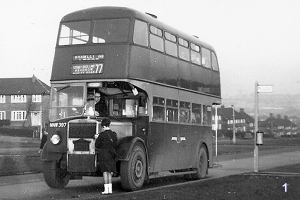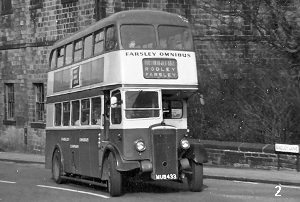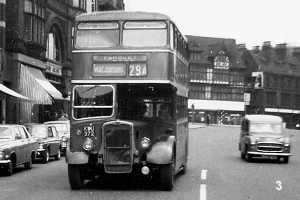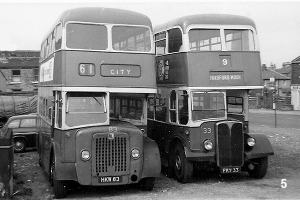Why I Became a Bus Enthusiast or "Buses Galore on Route 54" Part 1
Why I Became a Bus Enthusiast or "Buses Galore on Route 54" Part 1
In the 1950s, use of public transport was a daily experience for most people. As a child, I obviously used the buses, trams and trains in my area for school and leisure, but to understand why this daily use converted into enthusiasm is not easy to answer. However, I'm convinced that a major factor in this conversion from mere traveller to keen enthusiast was the sheer variety of buses on the road at that time. In Leeds in the 1950s and 1960s we had a huge choice of routes, operators and vehicles to see and to ride on.
I hope to prove this by taking you on this "virtual" journey by bus over what was Leeds City Transport's route 54 from Rodley to Halton Moor via the city centre. This was the route I used most during my early years and, to give it some context, lets imagine the trip was made on a summer Saturday in 1958, when I was 11 years old. At this time, I was a keen train spotter, but buses and trams also held my fascination, for the reasons explained here. Although I had a well-thumbed and much-valued Ian Allan Bus Fleets "Yorkshire Municipal" spotters book, a deeper knowledge of the other operators mentioned in this article was not to come until some years later.
 I accompany the article with photos of some of the
buses referred to, taken by me in the 1960s. Unfortunately they are not always seen at the locations or
on the routes referred to in the text. However, I hope they add to the interest.
I accompany the article with photos of some of the
buses referred to, taken by me in the 1960s. Unfortunately they are not always seen at the locations or
on the routes referred to in the text. However, I hope they add to the interest.
We start in Rodley, a small village suburb to the west of Leeds, at what was then the city boundary. This former tram route had been replaced by buses in 1938 and, during the 1950s, it was the preserve of the all-Leyland PD2s from Bramley depot which dated from 1949. It is on one of these buses that we make our virtual journey.

Climbing aboard our Leyland, we took the favoured upstairs front seat and immediately noticed that it was blue (leather upstairs for smokers, patterned moquette downstairs). This reflected the fact that our bus was built when the Leeds fleet was still blue, and not the two-tone green used throughout the 1950s and 60s.
 The conductor rang the bell and our bus departed,
with the assured tones of the reliable Leyland PD2/1 engine ringing in our ears, and soon we passed the
Smiths and Booths factories where mobile cranes and excavators were built for the Empire. For the first
mile of our journey we shared the road with West Yorkshire's Bristol Ks and KSWs running to and
from Leeds to Farsley, Bradford and Keighley. For Rodley passengers going direct to Leeds, these red buses
would be the quicker option, as they took a different route and had a limited stop restriction for part of
the journey. As an early enthusiast, I often liked to take these buses to experience their fast pace and
the novelty of sitting on the upper-deck bench seats of their lowbridge bodies, even though their nearest
bus stop was further from my house, but this didn't matter as I always ran everywhere in those days!
The conductor rang the bell and our bus departed,
with the assured tones of the reliable Leyland PD2/1 engine ringing in our ears, and soon we passed the
Smiths and Booths factories where mobile cranes and excavators were built for the Empire. For the first
mile of our journey we shared the road with West Yorkshire's Bristol Ks and KSWs running to and
from Leeds to Farsley, Bradford and Keighley. For Rodley passengers going direct to Leeds, these red buses
would be the quicker option, as they took a different route and had a limited stop restriction for part of
the journey. As an early enthusiast, I often liked to take these buses to experience their fast pace and
the novelty of sitting on the upper-deck bench seats of their lowbridge bodies, even though their nearest
bus stop was further from my house, but this didn't matter as I always ran everywhere in those days!
Soon we said farewell to the West Yorkshire buses which turned left and headed for Leeds via Kirkstall. Immediately after, we crossed the Leeds and Bradford Road and LCT route 23 at right angles, which also used the same batch of PD2s as ourselves. Once across the junction we paused at the bus stop, before engaging first gear to climb the steep Whitecote Hill - complete with a Compulsory Stop at the top for the descent, dating from tramway days.
Reaching the summit and barely out of first gear, we briefly crossed route 44 with its usual allocation of Roe-bodied AEC Regent IIIs, before we turned into Bramley Town Street. During our journey through Bramley we were joined by another PD2 route, the 77 which took a rather obscure route from the city. Then, soon after, orbital feeder single-deck route 73 came in from the left, whose buses could be one of the two Roe-bodied PS1s, or more likely one of the eight unusual Roe centre-entrance standee single-deckers with a mix of AEC Reliance, Leyland Tiger Cub or Guy LUF chassis.
At Bramley Town End, we could see Bramley depot, home to our PD2s and also a batch of Roe-bodied PD1s which started from there on the orbital route 46 to Belle Isle.

Turning left and heading for town, things started
to get even more interesting. Joining us on the run down Stanningley Road (separated by the old tram
central-reservation, abandoned in 1953) were Bradford's East Lancs-bodied AEC Regent IIIs on the
joint Leeds-Bradford route 72. Their delightful light blue and cream livery contrasted with the maroon and
cream of the Hebble buses which also used this road out of Leeds, en-route to Halifax, Burnley and
Rochdale.
Hebbles choice of bus for these services might have included their latest MCW-bodied lowbridge AEC Regent Vs or Weymann-bodied Leyland Royal Tigers with high-backed seats to reflect their long-distance route status.
Within minutes, we were briefly joined by route 45 - known locally as the "little bus" route - which also used the Roe centre-entrance standee single-deckers. Further down the road we reached the end of the old tram central reserved track and arrived at Armley Branch Road, home to the Samuel Ledgard head office and depot.
The Ledgard fleet was famous for being diverse (see Chris Youhill's excellent articles), and the chances are we would have seen one of their ex-London or Midland Red wartime Daimlers, or one of their all-Leyland PD1s running "light" to and from duties in the city, or maybe a Burlingham-bodied Tiger Cub coach heading to take up a seaside express or private hire duty. Also, at this location, Leeds route 49 crossed our path, probably being a Roe or MCW-bodied AEC Regent III.
To view a map for 'Route 54' Click here To read Part 2 Click here
Paul Haywood
02/2010
Photograph captions
1 Leeds City Transport - NNW 397 - 397
1949 Leyland PD2/1 Leyland H56R
Gipton 1966
2 Farsley Omnibus - MUB 433
Daimler CVD6 originally Wallace Arnold coach
of 1949 rebodied by Roe H61R 1957
Farsley 1968
3 West Yorkshire - KWU 372 - DBW 16
1952 Bristol KSW6B ECW L55R
Vicar Lane Leeds 1967
4 Leeds City Transport - MUG 452 - 452
1949 AEC Regent III Roe H56R
Whitkirk 1965
5 Bradford Corporation Transport
83 HKW 83 1952 AEC Regent III East Lancs H61R
33 FKY 33 1949 AEC Regent III Weymann H59R
Bankfoot 1967
6 Leeds City Transport - 36 TUA - 36
1955 Guy Arab LUF Roe B34C+24
Stanks 1966
"Many thanks to Paul Haywood for part one of his fascinating account of travel
on Leeds City Transport 'Route 54'. Even though I am very familiar with the area I find that this
refreshing approach brings back all the colour and atmosphere of the time to the topic.
Parts two and three are eagerly awaited."
Chris Youhill
Comments regarding the above are more than welcome please get in touch via the 'Contact Page' or by email at
If you have a bus related article that you would like to appear on this site please get in touch via the 'Contact Page' or by email at
All rights to the design and layout of this website are reserved Old Bus Photos does not set or use Cookies but Google Analytics will set four see this
Old Bus Photos from Saturday 25th April 2009 to Thursday 16th March 2023